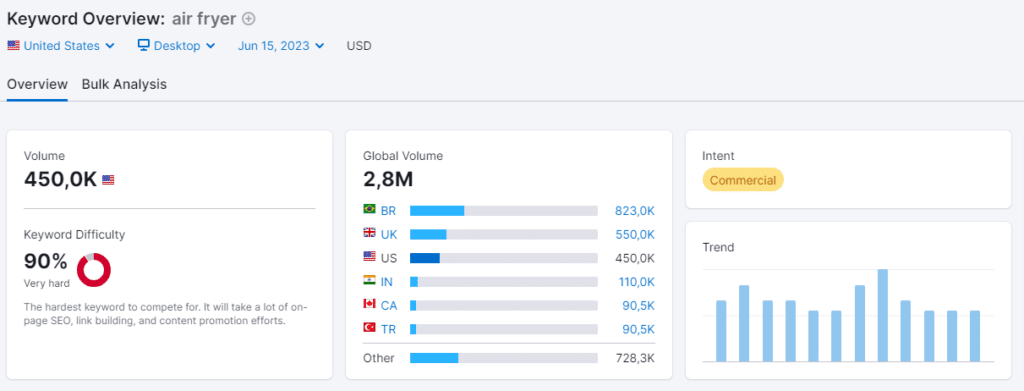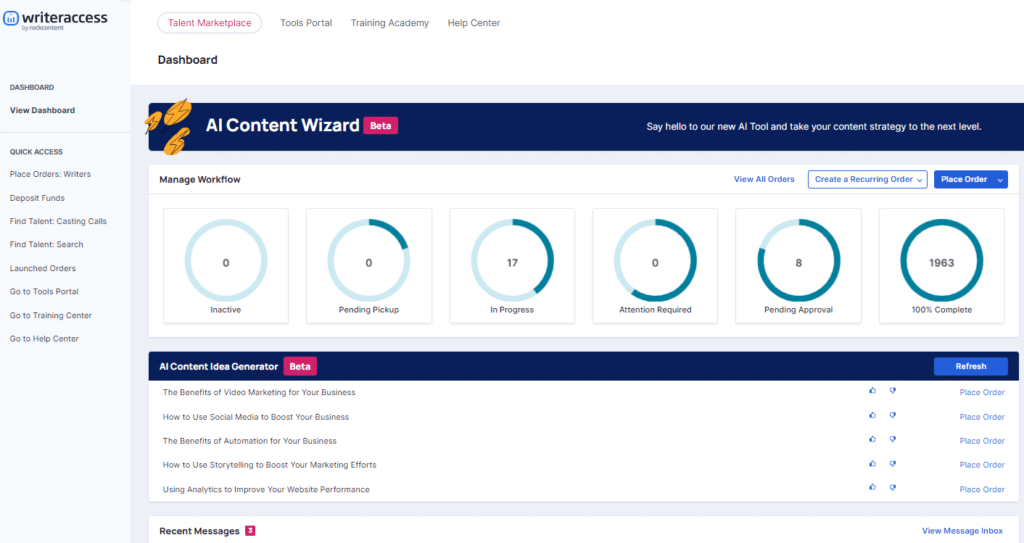While investing in fancy tools and following the latest marketing trends can help you get more business, what matters most is the content of your website. High-quality content is key to your digital marketing strategy today, and we’re here to help you streamline your website content creation process.
Without high-quality content, you can find it challenging to capture the attention of consumers and turn them into customers. Yet, website content creation is not always so simple.
You’ll need to start by devising a marketing strategy that will work best for your organization. After that, it helps to go one step further and determine the process for actually producing the content you will use.
In other words, you need a production plan to help enhance the workflow for your website content creation. Such a plan will save you time, resources, and even some frustration.
While every project will be different, applying this process will be beneficial and help you stay on track, especially if you plan to scale your content production to meet new demands.
- Content Creation for Websites
- What Defines Great Website Content?
- Build Your Content Production Plan in 7 Steps
- Common Mistakes Made by Content Creators
- Content Production Process Examples
- Content Creation Ideas for Inspiration
- Content Production Tools for Marketers
- Wrap-Up: Create a Content Production Plan that Rocks
Content Creation for Websites
In a business landscape that is increasingly about online connectivity and the reach a company’s web presence brings to the table, website content creation is more than just important. Your approach to it can actually make or break your brand. Here’s a closer look at how content works and why you should care.
What is website content creation?
The term “digital content creation” describes the process of brainstorming, applying, and realizing ideas meant to appeal to your target audience. That content can be written, as with blog posts and ebooks, or it can be more visual, as with infographics or videos.
Website content creation, in particular, describes this process as it applies to various elements of your actual website, as opposed to other aspects of your online presence (like your social media profiles).
Why is website content creation so important?
Content is at the center of how brands promote their products, build an audience, and establish trust with their existing and potential customers.
Consumers who stumble across what you’re doing will use your content to assess whether your products, services, and identity as a company are a fit for them. And search engines like Google will also be looking at your content and assessing its value to determine where your website should rank on various SERPs.
That said, website content creation is so important because it affects everything about your brand’s online visibility and eventual success. It’s vital that you get it right and establish a method that works for you.
What Defines Great Website Content?
This question may seem a bit philosophical or subjective at first, but you can quantify “great” website content with a few key metrics.
Here’s a quick rundown of what separates a great website from a mediocre one.
What is the content trying to do?
Asking yourself this question first will give you a much better idea of what to put on your website.
Are you an eCommerce retailer who wants to sell products directly to consumers?
If so, your content will vary wildly from a business consulting firm. As a retailer, you want your content to create more transactions.
So, you’ll focus on product descriptions, photos, videos, and other materials that show how great your products are and why people should buy them.
As a business consultant, your goal is to establish trust among potential clients.
So, your content should illustrate what makes you an authority within the industry. Even if you don’t have much experience consulting, you can promote your insider knowledge.
Overall, if your content matches your primary objective, it’s good.
What are people searching for?
Here is where keyword research will come into play.
Even though you may want to write about topics that are near and dear to your heart, are people going to pay attention?
Are enough people going to visit your website and consume that content?
If not, you should focus on more relevant topics.
Again, let’s use our eCommerce and business consulting firms as examples.
For the retailer, let’s say that they sell kitchen appliances. While there are tons of appliance makes and models available, not all of them are very popular.
For example, air fryers are having a moment right now, meaning that more users are likely searching for air fryers to buy.

If the retailer doesn’t feature air fryers on their pages, they could miss out on all that oil-free business.
For the consultant, what matters most is the kind of clients they want to attract.
Top-level executives? Small business owners?
In each case, the consultant needs to know how those potential clients are searching for help.
Then, they align their content to meet those needs.
Does the content deliver value?
Finally, once you know how to align your website content, you need to make sure it delivers.
Just because someone is searching for an air fryer doesn’t mean that you can simply show them a few models and call it a day.
Comparison guides, in-depth product demonstrations, and recipe ideas are excellent ways to entice users to make a final purchase.
Overall, excellent website content doesn’t just answer a question — it provides sufficient context too.
Associate with white-label SEO solutions
There is also an extra possibility, and it is becoming an agency to manage all your clients with good content and SEO services.
Being this your case, how about starting or expanding your services, by getting in touch with us to become a partner with White label SEO?
This way you provide SEO services to your customers, but without the need to hire specialized staff, invest in individual tools, or learn SEO from scratch.
Build Your Content Production Plan in 7 Steps
Once you devise your content management strategy, telling you the what, how, and why to publish, it’s time to get down to the nuts and bolts of producing the actual content. While we’ll focus on website content creation, we’ll also help you with your content production as a whole.
A content production plan is a defined process to not only generate high-quality content but to manage the overall workflow, from the initial idea all the way through to publication.
It can save you time, help you avoid inconsistency, accommodate communication between team members, and assist you in scaling your efforts when the time is right.
Of course, it’s not a one-size-fits-all plan but sectioned out to guide each type of content through the production process. These types of content may include website pages, blog posts, infographics, emails, interactive content, social media, video, and more.
Consider the following steps to crafting a fluid content production plan to increase efficiency and create the highest quality content for your organization.

1. Develop content governing resources
For consistency across all content, you need to create resources for content governance. What this means is you need to establish guidelines for your team to follow when it comes to specific aspects.
A few common examples of such resources include the following:
Style Guide
A style guide includes guidance on things such as grammar, capitalization, spelling, use of acronyms, design, and so forth.
It depicts how you want your brand represented and perceived via the content (written and visual) you produce and publish. The guide keeps content consistent across all formats (webpage, blog, video) regardless of what team member creates it.
Editorial Guidelines
Editorial guidelines will inform team members in what voice or tone to strive for in each piece of content, who the intended audience is, and what purpose it serves.
This resource may include information on buyer personas, content goals (e.g., stage in the buyer’s journey), keywords, and SEO practices that your content strategy identifies.
Templates
In some instances, templates will be invaluable assets to not only guarantee consistency but to save time conforming content to fit the format you want or need to achieve.
For example, by including a template for blog posts, your in-house or freelance writers will produce consistent content without missing essential elements.
When creating a new strategy or refreshing an old one, a solid content audit is always the best place to start. Once you’ve established your goals, look through your existing content and determine whether or not it’s in line with those goals. Refresh, reorganize, delete, or add to that content accordingly.
2. Identify all content formats
Identify all the content formats that your team will need to create.
List them out: webpages, emails, blogs, videos, social media posts, infographics, eBooks, whitepapers, or any others that are relevant to your digital marketing strategy.
This step will show you how many potential workflow variations you will need and also help determine how many team members you require to complete each piece of content.
For example, you may include blog posts, videos, and infographics in your content marketing.
Blogs will usually require a writer and an editor, while video content needs several team members, from scriptwriters to video editors. To create infographics, you may need to bring in a graphic designer as well as a writer.
3. Map processes for each type of content
For each type of content that you plan to produce, map out the entire process, from initial research all the way through to publication. By doing so, you can create repeatable workflows that are easy to follow.
For instance, the process to produce blog posts may involve the following steps: research, write, edit, revise, review, approve, upload, sign-offs, and publish.
Content can stall at different steps, so account for this also. For example, once at the review stage, be sure to include who can make the final decision on the content in this part of the process, so it doesn’t linger longer than necessary.
4. Assign roles
Determine who will be responsible for each step in the process. For example, you may start with a freelance SEO writer composing the content before it goes to an in-house editor for the first review.
Depending on the type of content, you may need a variety of team members involved, including writers, editors, proofreaders, illustrators, photographers, videographers, or graphic designers.
Once you assign roles, be sure to communicate responsibilities to each team member also. Provide them with access to the style guide and any other resources you deem necessary.
5. Establish timelines and due dates
Determine due dates for each step in the process and include these on your calendar or work schedule. To help with this, do your best to estimate how much time each step will take. You can always tweak this later on as you understand more about how each stage and team member contributes.
Also, consider your publishing schedule. Will your new blog posts go live each week? If so, determine how much time you will need before then to complete the content for it. You can do the same with social media posts and any other content that has a determined pace of publication.
6. Automate all you can
Automating as much of the process as you can helps to increase collaboration between team members involved in the production of the different types of content. It can also boost overall productivity by saving time and streamlining the process.
Automation can also help you track each step, so you can identify where changes need to be made.
Consider one of the marketing collaboration software options available today, such as Google Workspace, Trello, or Slack.
7. Inventory all content
Keeping track of your content, including drafts and final publication pieces, is essential, and one way to accomplish this is by determining the best way to inventory it all.
Start by selecting a system or program to organize all your content files. Find one that you can include working and final files, templates, images, logos, photographs, videos, audio files, website components, and so forth.
You may go with a simple one, such as Microsoft OneDrive, Dropbox, or Google Drive. Yet, higher priced ones such as CoSchedule’s Asset Organizer may be a better option for you, depending on your needs and budget.
Organize all content with file names and folders that make it easy to access what you need when you need it without having to spend too much time searching the entire inventory.
From here, begin to implement your plan. You will also want to consider how to measure the results of your content to determine where changes need making along the way to achieving your goals.

Common Mistakes Made by Content Creators
Creating content can often get overwhelming, and it is no small job. You have to deal with deadlines and your boss’s expectations, if you have one. These, and many more, are why businesses with a long history of immense branding success fail to create impactful content.
It’s okay to champion a new creative process and ideation model or try out a new tone in your content. What is not okay is expecting improved results immediately or equating wide readership for impactfulness.
This leads us to the first of many common mistakes content creators make.
1. Writing for everyone
There are so many metrics to consider in the content game. While the number of reads increases your chances of selling, we like to pay special attention to the number of times an article is shared.
Why? Because readers sharing your article means three things:
- They read the entirety of your article;
- Your readers trust your content;
- They think that a friend or colleague would share the same sentiment.
Writing for a general audience can quickly run the reading numbers up, but it comes with a price of low conversion rates.
When you write for a specific ideal customer profile (ICP), you increase your chances of resonating with them than if you threw them into the general profile cluster. Consequently, they become marketers of your content and service free of charge.
This is the goal of every content creator and marketer worth their salt.
2. Changing too many things
Programmers have this saying, “If it works, don’t touch it.” We think that applies to everything else.
We are not asking you to be stagnant or change-adverse; we are trying to say that you shouldn’t chase change or innovation so much that you ignore best practices.
Even industry experts understand that fixing too many things in one go can set you back in resources. Instead, maintain what works and make simple tweaks throughout your content structure.
It can be using infographics or making typefaces bolder to improve contrast.
Track your audience’s reception to these changes. Does the data suggest better engagement or lesser reading time? Better still, take a survey that evaluates their experience. Ask how you can improve their experience with your content and take steps to do so.
3. Thinking distribution will handle itself
How you distribute your content plays a significant role in its effectiveness, including how your audience perceives the content and the effect it will have on them.
When you don’t consider distribution channels when creating content, you suggest you don’t want to market to anyone — and you’re going to get results in that.
Yes, that’s the vibe it gives off.
Because content format, tone and form change with media channels, you should be specific with your brand output.
Have a distribution strategy that allows you to meet your target audience in the shortest time possible compromise, including finding the platforms that are more natural to the service you offer. Or products you want to sell.
Content Production Process Examples
Once you have created your style guide and any other content governance resources and determined how to assign responsibility to team members, you’ll need to list out the steps for each type of content you wish to produce.
Here are a few content production process examples for different content types.
Blog Posts
- Create a content brief and outline for each blog post.
- Send to the writer (via collaboration software)
- Write the content adhering to the Style Guide and submit
- Editor receives notice that content is submitted and begins the editing process
- If revisions are required, the content is sent back to the writer
- Final review, including SEO
- Sign-off by owner (stakeholder)
- Publish
Social Media Posts
- Review subject matter or content brief
- Compose social media post
- Research and incorporate hashtags
- A graphic designer or videographer creates visuals to go with the post
- Obtain review and final approval
- Schedule for publication on social media platform(s)
Webpages
- Research needs for a specific webpage
- Write content
- Review and edit
- Revise if necessary
- Send for approval
- Upload to CMS
- Review the Web Page Layout before it goes live
- Publish

Content Creation Ideas for Inspiration
It’s currently estimated that there are around 1.14 billion websites in existence around the world. Each of those websites potentially contains hundreds (if not thousands) of pieces of content. And there are social media to consider, where a limitless amount of content goes live every single minute of every day.
That said, it’s pretty safe to say that there is no topic or subject matter that hasn’t been touched on before when it comes to website content creation. But your brand’s point of view is one of a kind, so it’s also the key to creating compelling, original content that gets results.
Here are some ideas to use as a jumping-off point for inspiration.
Answer a common question
Search engine users who wind up on one website instead of another are often there because they had a question that website appeared to answer better than the others. So consider which questions your existing or potential customers have the most often, and use them as the basis for creative content that addresses the answers.
Teach your audience something
Some of the most successful content pieces of all time are teaching tools that help people figure something out or teach them something they didn’t know before. Consider ways you can use blog posts, video content, graphics, social media, and more to clarify complex topics in an approachable way or shed new insight on issues that have been heavily covered.
Celebrate an accomplishment
Although timeless evergreen content is a massive part of any thorough website content creation strategy, it’s a good idea to add variety and mix things up now and then. One way to do this is to alternate pillar topics with timelier ones, including events and wins that are unique to your company.
There are many ways you can do this. You can announce new product developments or celebrate accolades your company might have earned lately. You can honor top members of your team or even shine a spotlight on some of your best customers. These (and similar options) are great ways to humanize your brand.
Weigh in on trends
Trending topics make terrific subject matter for website content creation, especially when those topics are in line with your current brand identity. They’re also great ways to spark discussion via many different types of content, including podcasts and videos. As always, your unique take on the topic of the hour is the ticket to standing out in a sea of content weighing in on the same thing.
Repurpose past content
If there’s a particular topic, approach, or take on content that’s worked exceptionally well for you in the past, consider converting it into a different medium to freshen it up and give it a new lease on life. For example, successful blog posts can easily become the basis for equally great videos, infographics, and more.
Content Production Tools for Marketers
Getting the help necessary to help you scale can be costly for your small brand, or the readily available help is not at that skill level yet. Behind every successful marketer is a smart and experienced team or, in some cases, an arsenal of tools.
You need all the help you can get to achieve your marketing goals.
1. WriterAccess
Finding the writer that gets you and understands your business needs is like finding a needle in a haystack — satisfying when you do, but a harrowing experience.
This is why platforms like WriterAccess exist. WriterAccess connects you to a network of expert content writers and marketers you can hire on a one-time, contractual or full-time basis.
On average, it costs $4,700 to hire a new employee, and it can be several times that amount if you consider the adaptation time and the momentary pause in your marketing efforts.
You avoid these pitfalls when you use the WriterAccess platform. Plus, there’s the bonus of innovative thinking and fresh perspective owing to their diverse experience.

2. Google Trends
On some days, ideation can be incredibly fast, and painstakingly slow on others. It is on the slow days that you need tools like Google Trends.
Google Trends is a utility tool that tracks keyword usage and popularity. Available tracking data and insights can be sorted by date, time and category.
Seeing how these search terms and interests stack up against each other can give you months of content ideas you can build on. This way, you plan your content production in a way it captures trend pursuers and turns them into loyal consumers.
3. Hemingway App
Nothing turns off a reader better than a mechanical content piece that doesn’t give clear direction on where to go next. Writing the way you speak is the key.
If you take a mental note of how you speak, you’ll discover that every word has a purpose and a direction. However, this can be hard to replicate in writing because people rarely give long speeches. Visual cues give speaking its power, unlike bland texts on a white background.
The Hemingway App is an editing app that ensures that your final output is readable, actionable, and jargon-free for the average reader. Clear writing with underlying maps of the actions you want the reader to take requires great skill; the Hemingway App bridges this skill gap considerably.
4. Giphy
We just talked about how texts couldn’t convey gestures and facial expressions as speaking would, and why you should write conversationally — or at least try to.
One of the many ways to make your blogs and social media posts personable is by adding GIFs and stickers. Giphy is the search engine for GIFs and animated stickers that add spice to your article.
Ensure that the GIF ties in with the topic for better effect. You can take it further and make a GIF using an inside joke. With time and careful refinement, your brand strategy and content production efforts will pay off.
Wrap-Up: Create a Content Production Plan that Rocks
Creating a content production plan can help your organization achieve its goals faster and avoid inconsistencies that threaten its brand reputation. It also helps to identify where you can benefit from working with outsourced assistance, such as with the experienced writers at WriterAccess.
WriterAccess is the ideal platform to help you streamline your content production, combining the efficiency of AI-powered tools with the creativity of human writers.
Ready to find out more and see how WriterAccess can help? Start with the 14-day free trial to become familiar with the platform and discover how it can benefit your content production plan.








